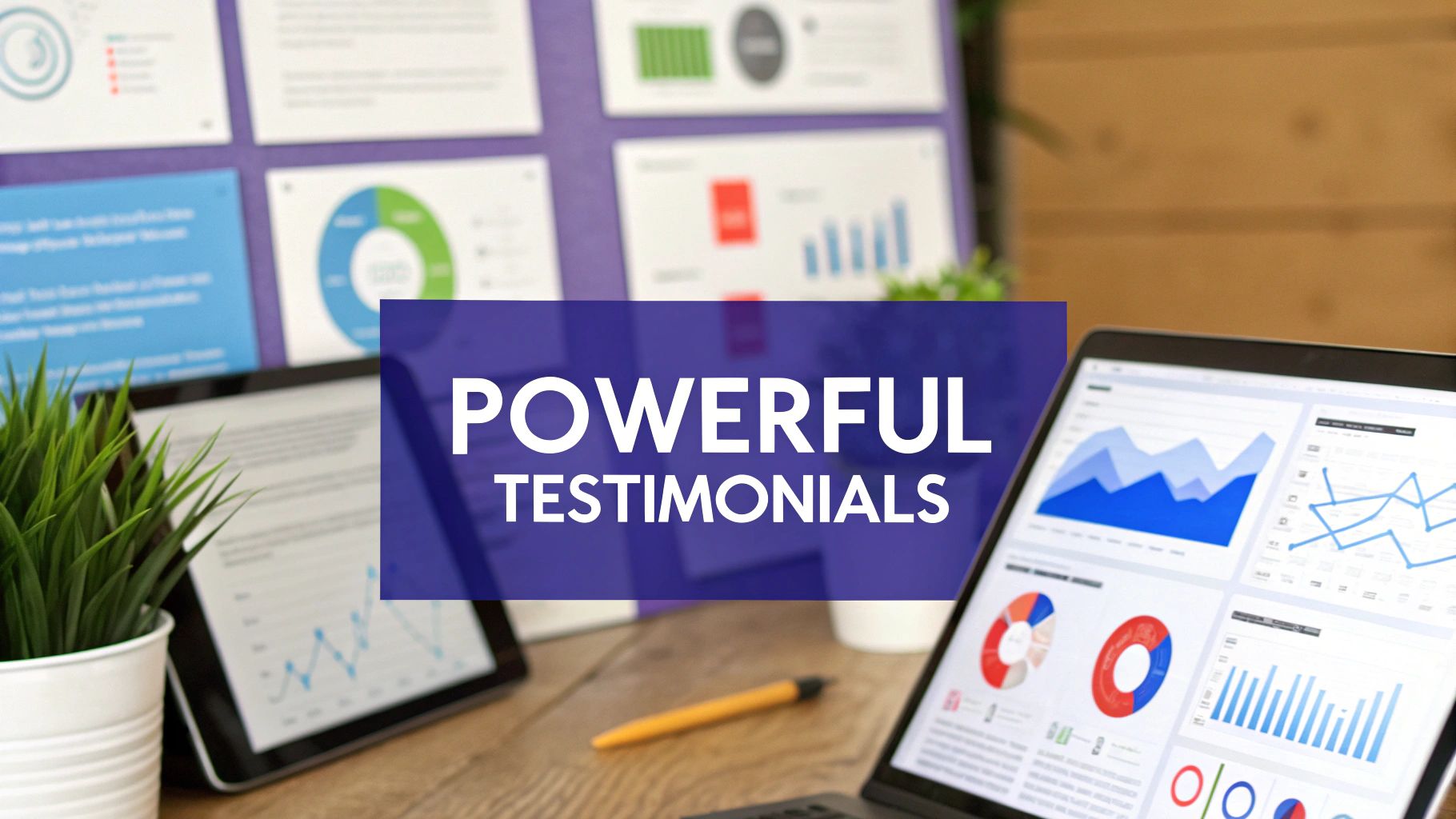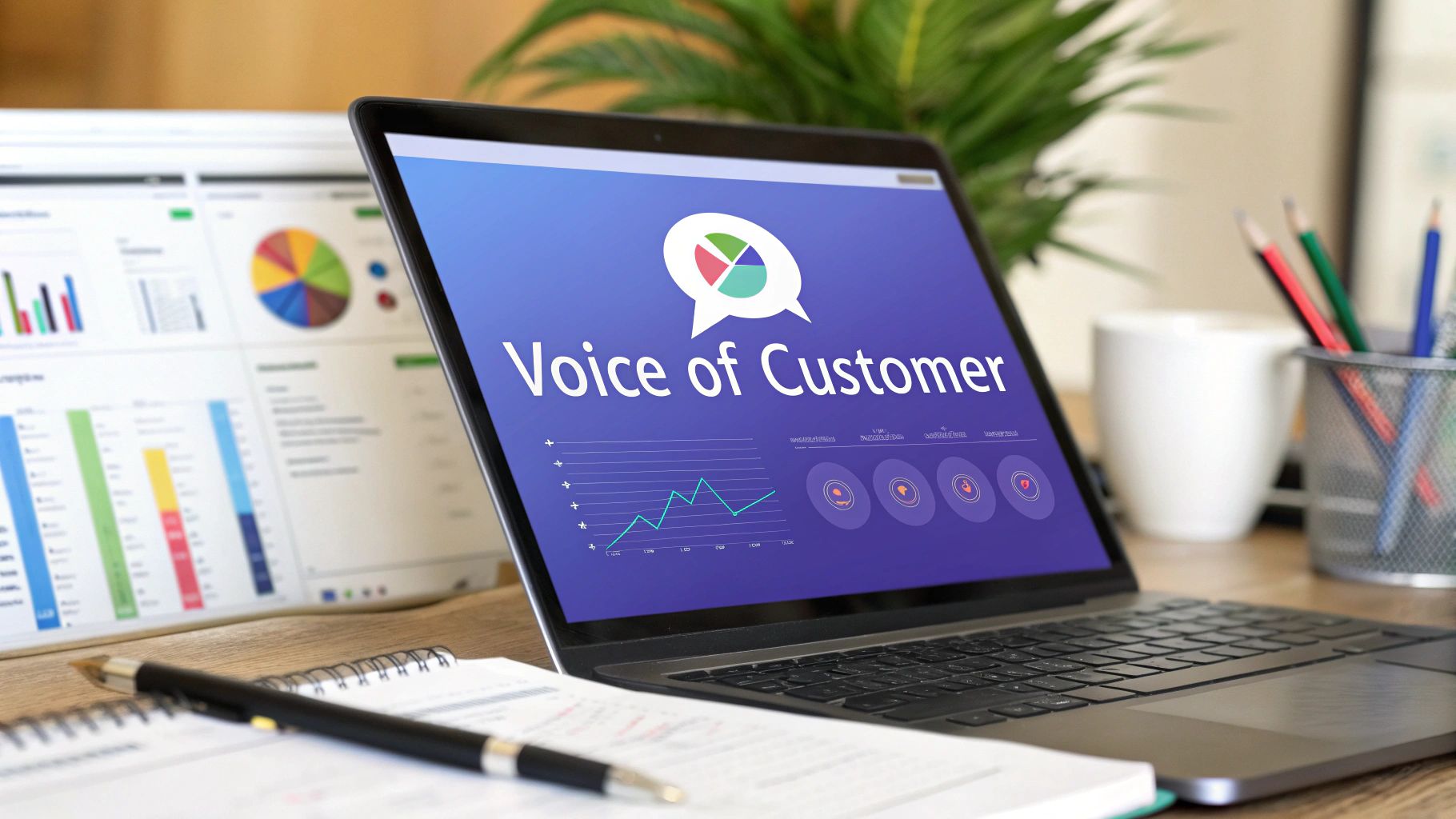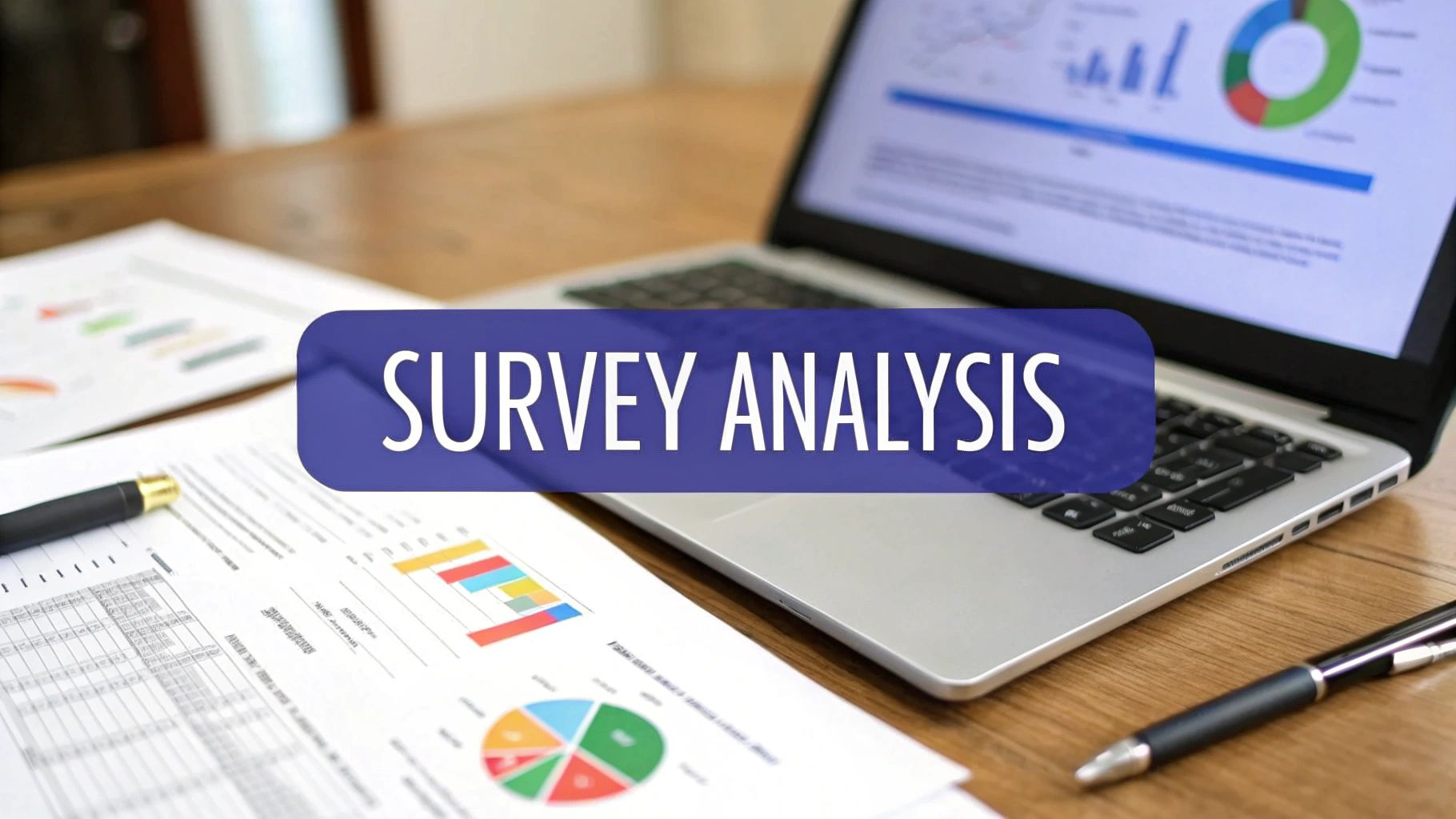Boosting Your Survey Response Rate
Tired of low engagement? Learn proven strategies to dramatically increase your survey response rate with our guide on design, distribution, and follow-up.

Ever wonder what a "good" survey response rate even is? It’s a common question, and the answer isn't always straight forward. While a general benchmark for external surveys is often quoted around 30%, that number can swing wildly depending on who you're asking and how you're asking them.
For instance, internal surveys sent to your employees can see much higher engagement—sometimes even north of 70%. That makes sense, right? They have a vested interest in providing feedback that shapes their workplace.
What Is a Good Survey Response Rate?
Before you can improve your numbers, you need to set a realistic goal. There's no single magic number here. A successful response rate is all about context: your audience, your relationship with them, and the channel you're using to send the survey.
The way you collect feedback in the first place sets the stage for the kind of response you'll get. If you want to boost the quantity and quality of your responses, it's worth exploring the different proven ways to collect customer feedback to find what works best for your audience.
This infographic gives a great breakdown of what you can typically expect from different channels.

As you can see, nothing beats the engagement of an in-person survey. Phone and email, while popular, have more modest results. It's a clear reminder that the channel you pick has a direct line to how many people will actually participate.
Setting Realistic Benchmarks
The single biggest factor influencing your response rate is your relationship with the recipients. An internal poll with your team will almost always crush an external survey sent to a cold list of prospects.
For example, global employee census surveys pull in an average response rate of about 76%, with most companies falling somewhere between 60% and 92%. It shows just how engaged an internal audience can be.
A quick look at average response rates for different kinds of surveys can help you set realistic benchmarks.
Average Survey Response Rates by Channel
Survey TypeAverage Response RateKey Influencing FactorIn-person surveys57%The direct, personal interaction builds immediate trust and encourages participation.Mail surveys50%A physical, tangible survey can feel more significant than a digital one, but it requires more effort from the recipient.Phone surveys29%Success heavily depends on the caller's skill and the recipient's willingness to engage in an unscheduled call.Email surveys29%A strong subject line, a clear call-to-action, and a trusted sender are crucial to stand out in a crowded inbox.Website pop-up surveys1-3%Often seen as disruptive, so the timing and relevance of the ask are absolutely critical for even minor engagement.
These numbers aren't set in stone, but they give you a solid starting point for what's achievable with each method.
Key Takeaway: A 15% response rate might be a massive win for a broad market research survey but a major red flag for an internal feedback poll. Context is everything.
So, when you're setting your goals, think about these key elements:
- Audience: Are they loyal customers who love your brand, or are they a general audience with no prior connection?
- Topic: Is the survey about something they genuinely care about, or is it just another request for their time?
- Incentive: What's in it for them? Is there a clear and compelling reason for them to hit "submit"?
By thinking through these factors, you can stop chasing generic averages and set a target that’s both meaningful and totally achievable for your next survey.
Designing Surveys People Want to Finish

Nothing tanks a survey response rate faster than bad design. A confusing layout, an intimidating wall of text, or unclear questions will make even your most loyal users close the tab. The secret is to make your survey feel less like a stuffy interrogation and more like a quick, interesting chat.
It all starts with a compelling and honest introduction. Be upfront about how long it will take and what you plan to do with the insights. Transparency builds trust from the very first click. For example, ditch "Your feedback is important" and try something like, "Help us build a better feature for you. This will take 3 minutes." See the difference?
Crafting Clear and Neutral Questions
The way you word your questions has a massive impact on everything—from completion rates to the actual quality of the data you collect. If your questions are vague or leading, you're not just confusing people; you might be pushing them toward an answer they don't actually believe.
Your goal should be simple, direct, and neutral language. Drop the corporate jargon or internal acronyms that your audience won't get.
- Leading Question: "How much did you enjoy our amazing new feature?"
- Neutral Question: "How would you rate your experience with our new feature?"
That simple tweak is the difference between getting skewed, feel-good data and honest feedback you can actually use to improve. If you want to dive deeper, it's worth exploring the different types of survey questions and learning when each one works best.
Ordering and Format for a Better Experience
The flow of your survey is just as important as the questions themselves. A strategic order keeps people engaged and prevents them from getting overwhelmed.
Kick things off with easy, general questions to get them warmed up. Save the more complex or sensitive questions for the middle, and always, always put demographic questions at the end. Asking for personal info right out of the gate can feel intrusive and is a surefire way to increase drop-offs.
Pro Tip: With over 60% of online surveys now opened on mobile, a mobile-first design isn’t just a nice-to-have—it’s non-negotiable. Make sure your buttons, scales, and text are easy to read and tap on a small screen.
Finally, think about format. Multiple-choice and rating scales are quick and easy, which helps maintain momentum. Use open-ended questions sparingly. They require more effort from the user, so save them for when you absolutely need that rich, detailed context. By balancing these elements, you create an experience that respects your user's time and gives your response rate a serious boost.
Nailing Your Survey Timing and Distribution
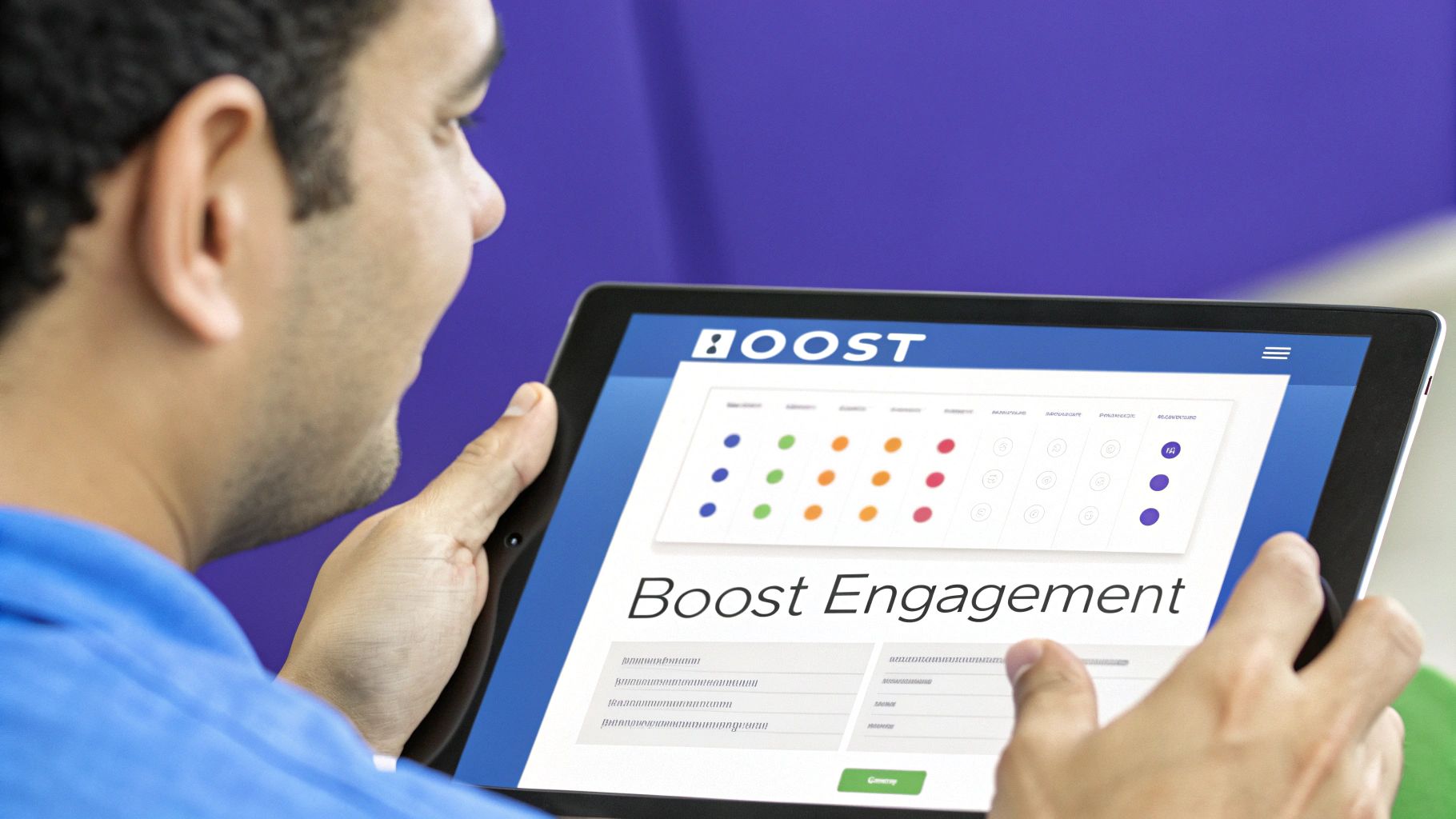
You can craft the most brilliant survey in the world, but it’s completely useless if it never reaches the right people—or if it arrives at the worst possible moment. How you get your survey out there is just as critical as the questions you ask.
Think of it this way: sending a B2B survey at 9 PM on a Saturday is like shouting into an empty office. You have to meet your audience where they are, and when they’re most likely to listen. An email campaign might be perfect for your existing customer base, while a website pop-up is great for grabbing in-the-moment feedback. For younger crowds, you might even find that SMS or a quick social media poll gets the best results.
Choosing the Right Time and Channel
When it comes to timing, the old wisdom often points to mid-week mornings. Tuesdays and Wednesdays usually get the most love for email engagement, since people have settled into their work week but aren’t quite mentally checked out for the weekend yet.
But that’s not a hard-and-fast rule. You need to think about your specific audience.
- B2B Audiences: Aim for business hours. I've found the sweet spot is often between 10 AM and 2 PM, when people are at their desks and focused.
- B2C Audiences: You might have better luck catching people during their downtime, like evenings or weekends, when they have more personal time to spare.
If you’re going the email route, deliverability is everything. To make sure your invitations actually land in the inbox, it’s worth brushing up on the basics. This ultimate email deliverability guide is a great resource for avoiding spam filters that can kill your response rate before you even begin.
A great survey sent to a spam folder has a 0% response rate. Mastering the basics of distribution is the foundation of getting good data.
Interestingly, while some channels see ups and downs, the overall trend for response rates has been surprisingly positive in certain areas. One analysis of scholarly journals from 2005 to 2020 saw a steady climb in engagement, growing from a 48% response rate to 68% over 15 years. It just goes to show that with the right approach, getting people to respond is more achievable than ever.
How to Use Incentives and Reminders Without Annoying People
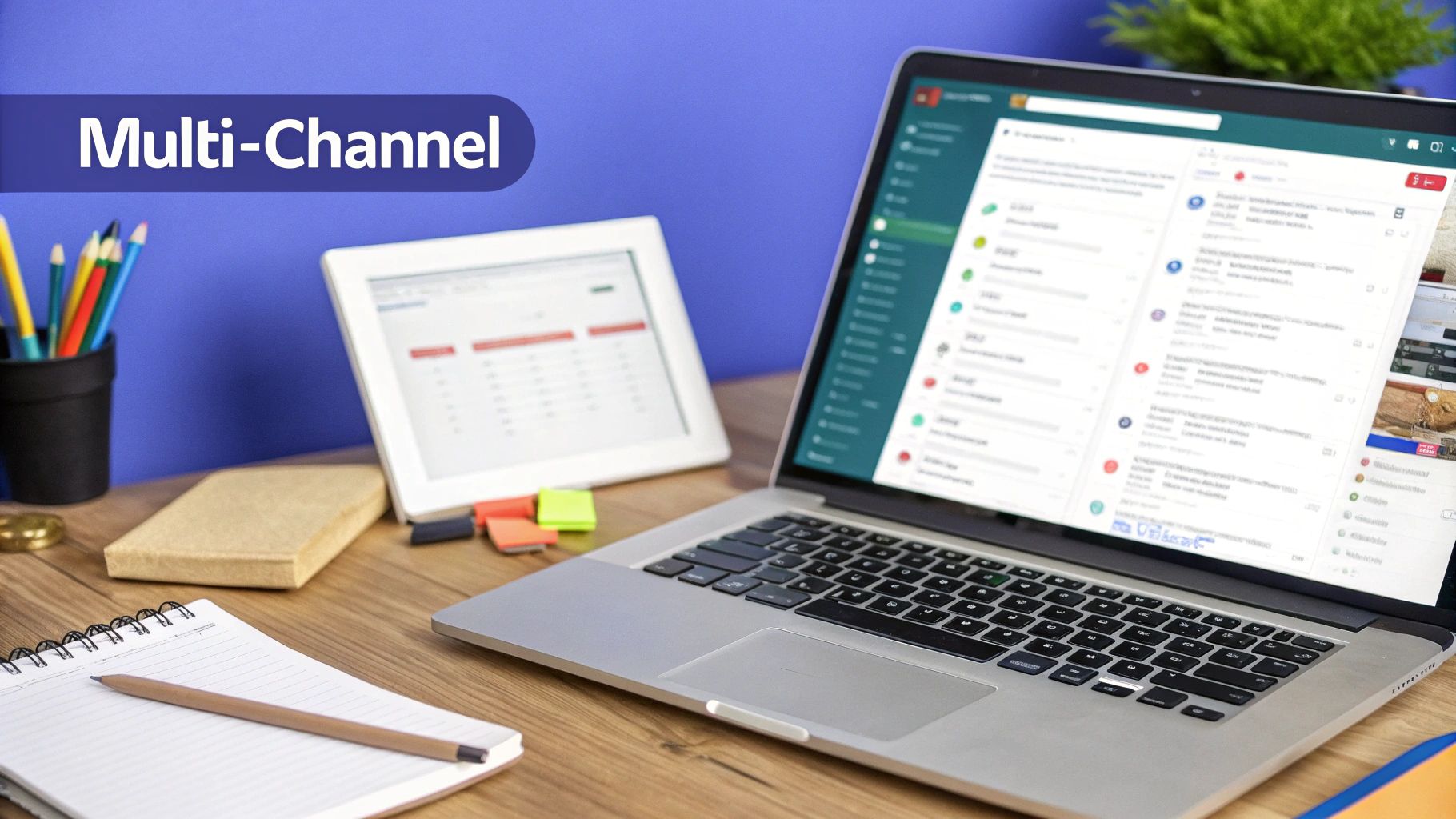
We've all been there. You get an email asking for feedback, and then another… and another. Incentives and follow-ups are fantastic tools for boosting survey responses, but they walk a razor-thin line between being helpful and just plain annoying.
If you get it wrong, you risk alienating the very people you need to hear from. The secret isn't just about offering rewards or sending reminders; it's about finding that sweet spot of motivation and gentle persistence.
This starts with understanding what really drives someone to act. You can offer a direct reward, which taps into extrinsic motivation, or you can appeal to their desire to help improve a product they already love—that’s intrinsic motivation. Both work, but the best results come from tailoring your approach to your audience and the survey itself.
Choosing an Incentive That Clicks, Not Bribes
A good incentive feels like a genuine "thank you" for someone's time, not a bribe to get what you want. The trick is to match the value of the reward to the effort you're asking for. A long, complex survey might call for a bigger reward, while a quick two-question poll probably doesn’t need one at all.
Think about what your audience actually wants. Here are a few ideas I've seen work well:
- A small discount: Offering 10% off their next purchase is a classic for a reason. It’s a simple, direct reward that strengthens their connection to your brand.
- A charitable donation: For audiences who aren't swayed by discounts, offering to donate $1 to a charity for every completed survey can be a huge motivator. It makes people feel good about participating.
- Exclusive access: This is gold for B2B and SaaS audiences. Offering early access to a new feature or exclusive content rewards them with status and a leg up on the competition.
Choosing the right incentive shows you get your audience, and that alone makes them more likely to respond.
The most effective incentive is one that feels thoughtful and relevant. A coffee voucher might work for a general consumer survey, but early access to a beta feature is far more compelling for a dedicated SaaS user.
The Art of the Gentle Nudge
Even with a killer incentive, life gets in the way. People are busy and surveys are easy to forget. A well-timed reminder can make a huge difference in your response rate, but you have to know when to stop. Send too many, and you’ll just come across as nagging.
A good rule of thumb is to send one or two reminders, spaced a few days apart. It's all about the phrasing. Keep it light and friendly. Something like, "Just a friendly reminder to share your thoughts," lands much better than a demanding, "We still haven't received your survey."
For a deeper dive into this, we've put together a full guide on how to improve your survey response rate with even more actionable tips.
Turning Feedback into Action and Building Trust
Getting a great survey response rate is a fantastic start, but it’s really just the beginning of the journey. The real magic happens when you show people that their feedback didn't just get filed away into a digital black hole. If you want them to take your next survey seriously, you have to prove you were actually listening.
This is all about closing the feedback loop. When you share what you learned—and more importantly, what you’re changing because of it—you build an incredible amount of trust. It’s a simple act, but it transforms a one-time respondent into a long-term feedback partner who feels valued and heard.
Communicating Your Findings
You don't need to bog people down with a full data dump. A quick, clear summary of the most important findings is way more powerful. For instance, after wrapping up a customer feedback survey, you could send a follow-up email with a punchy subject line like, "You Spoke, We Listened: Here’s What’s Changing."
Inside that email, you can get straight to the point:
- Key Finding: "A majority of you (65%) told us our new dashboard was a pain to navigate."
- Our Action: "Because of your feedback, we're rolling out a redesigned, more intuitive dashboard in Q3. Here's a sneak peek."
This kind of direct, cause-and-effect communication shows you respect their time and effort. It tells them their input has a direct line to your product roadmap, which is a huge motivator.
When participants see tangible outcomes from their feedback, they are significantly more likely to participate in future surveys. Transparency is the most powerful tool for building a loyal feedback community and sustaining a high survey response rate over time.
Of course, once you have the responses, you need to analyze them properly. A huge part of turning opinions into action involves mastering customer satisfaction score calculation to accurately quantify what people are feeling. By sharing those results and your game plan, you complete the cycle and build the trust you need to keep improving.
Still Have Questions About Survey Responses?
Even with a perfectly planned survey, you're bound to run into a few head-scratchers when it comes to getting people to actually respond. Boosting engagement is part art, part science, and it’s totally normal to hit a few roadblocks. Let's tackle some of the most common questions that come up.
Why Are My Survey Response Rates Suddenly Dropping?
If you've noticed a dip in your response rates, you're definitely not alone. A huge culprit here is survey fatigue. Let's face it, people are asked for their opinions all the time, and eventually, they just start tuning it all out.
Another common problem is a weak "why." If someone doesn't immediately grasp the purpose of your survey or see what's in it for them, they're going to hit delete without a second thought.
The channel you're using also matters immensely. For instance, telephone survey response rates have absolutely tanked over the years. Data from the Pew Research Center showed a fall from 9% to a mere 6% between 2016 and 2018 alone, largely because robocalls have made everyone suspicious of unknown numbers.
Why Are B2C Response Rates So Much Lower Than B2B?
This one almost always boils down to two things: relationships and motivation.
In a Business-to-Business (B2B) world, the person you're surveying usually has a professional stake in your product. Their feedback could directly lead to improvements that make their job easier or their company more successful. That’s a powerful built-in reason to participate.
But in a Business-to-Consumer (B2C) setting, the relationship is often more transactional. A customer might love your brand, but they don't rely on it for their livelihood. This means you have to work much harder to grab their attention with a great incentive, perfect timing, and a super clear value proposition.
Key Insight: B2B surveys resonate when they appeal to professional gain and partnership. B2C surveys win by being incredibly convenient, emotionally engaging, or by offering a clear, immediate reward.
Which Question Types Get the Best Responses?
When it comes to getting people to the finish line, simplicity is your best friend. Questions that are quick and easy to answer keep the momentum going and prevent people from getting overwhelmed.
- Multiple-Choice Questions: These are the fastest to get through. They give you clean, easy-to-analyze data and are a lifesaver for anyone taking your survey on a mobile device.
- Rating Scales (like 1-5 or 1-10): Similar to multiple-choice, these are low-effort and give you quick, quantifiable feedback on things like satisfaction or agreement.
- Open-Ended Questions: These are gold for gathering rich, qualitative insights, but they also require the most effort. Use them sparingly. Too many, and you’ll see people drop off before finishing.
The real magic is in finding the right balance. You need enough simple questions to keep them moving but enough open-ended ones to get the deep insights you're after. For a more detailed breakdown, check out our complete guide on how to increase your survey response rate.
Ready to turn feedback into growth? Surva.ai gives SaaS teams the tools to understand users, reduce churn, and build better products. Start your journey with Surva.ai today.
